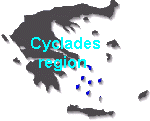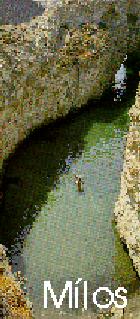| MILOS |
 |
 |
This description provides information of ancient sites, seaside resorts, churches, monasteries, landscapes and small towns and villages. Additional details can be found in various books printed on Greece, such as the 'Blue Guide to Greece.' The names of places conform to the accented Greek pronounciation which would be the one a traveller would face upon a potential visit.
For a general map of the Kyklades, click here!(55K).
To go back to the Kyklades main page, click here!
Milos (pronounced M�los) is found on the South Western part of the Cyclades and has a surface area of 161 square kilometers. Volcanic in origin, the island has two peaks, Prophet Elia at 722 meters and Hontro Voun�, at 523 meters.
In contrast with other islands, M�los has plenty of flora composed of pine and olive trees, fig trees, and in some places, palm trees. Much of the island is rich in mineral deposits composed of different types of metals and iron ores.
M�los has one of the oldest histories of all the cyclades, with the earliest recorded times of around 5000 B.C. Flakop�, the oldest settlement on the island, was in existence at between 4000 and 5000 B.C. The settlement was destroyed twice by invaders and was finally re-built in 800 BC in a different style. The ability to take advantage of the various mineral ores and (zinc, tin etc) gave the inhabitants a plethora of tools having incredible precision for those years.
Flakop�'s existence is situated between the neolithic and iron ages, as many recent archaeological excavations have found out. At the end, the town was burnt down. The end of Flakop� came at around the same time as the Mycenaen civilisation was flourishing elsewhere. It was around 1000 B.C. and at that time the D�rian invaders arrived on the island. In fact, Thoukidides reported in one of his books that it was for about 700 years that the Dorians made Milos their home.
|
Ove the years, M�los became a center for artistic endevour as shown by the wonderful statue of Aphrodite of M�los, created around 400 B.C. and currently on display at the Louvre Museum of Paris. |
 |
M�los today is a beautiful island, with excellent beaches, wonderful bays and amazing natural resources, seen as the ship arrives where the color of houses (white) and the earth color(also white - used for Porcelain) create quite an image.
ADAMAS
This is the port of entry and a south facing seaside resort with absolutely brilliant still waters no matter what the sea is like. Looking at a map, M�los looks like a pacific island reef!
PLAKA
Pl�ka is the main town on the island. It is built on a rather flat valley with a cycladic arthitecture. On top of the hill, the ruins of a Frankish castle can be examined and a beautiful view is available for those doing the 30 minute climb. Inside the castle the church of Thalas�tra is situated which was built in the 13th century.
Plaka also has a must-see cemetery (if you can call a cemetery a must-see!). The cemetery looks like a series of catacombes where the rich and poor are buried side by side. In the nearby museum there is an exact copy of the sculpture of Afrodite of M�los (Venus de Milo) which was sent by the Muesum of Louvre in Paris.
Near the town, there are wonderful Roman mosaics (near a place called Tramithi�) and the village Tripit� where the real Afrodite lived. In a place called Kl�ma, there are catacombs dating back to the beginning of the Christian era.
POLLONIA
On the way to this village, visitors will meet a small settlement called Triov�salo, built by three bothers who returned and built it. Further on, there is the village P�ra Triov�salo where in the church of Saint George, a folk mosaic made of colored shells can be seen in front of the entrance.
Poll�nia, is the second most important town of the island, built on the north eastern part of the island, right on the sea. Nearby can be found the ruins of the ancient town of Flakop�. Going south, for about 5-10 kilometers, one meets Voudi�, a great beach, affected by the Meltemi winds of the late summer.
Also nearby are the Glaronisia, four little islands famous for the wonderful caves that are found there. Boats from Poll�nia take visitors for thrilling visits.
ZEFIRIA
A very nice village, which used to be the ancient capital of the island, until the 18th century. Now, an agricultural center with vines, olive trees and pressing machines and co-ops. In the village can be found the church of Panagi� Portian� built in 1889.
HIVADOLIMNI
The nicest beach of the entire island is found here, while nearby, there are medicinal spas intended for arthritic sufferers.
MILOS BOAT TOUR 
A tour of the island by boat is a must. It will take about 10 hours, a complete day, but well worth it.
First we meet the island of Antim�los which contains much rocky outcrops designed for rockclimbers. On it, a special type of goat exists which can be seen jumping from rock to rock. The area is a national park.
On the west side, we should try and visit the monastery of Saint Paul and further on, we should look out for a rock formation called 'bears' (arkoudes).

Hotels |
Adamas, 0287/ 22322
Afroditi, 0287/ 22020
Chronis, 0287/ 22226
Corali, 0287/22204
Gianoulis, 0287/22631
Meltemi, 0287/22284
Milos, 0287/22087
Popi, 0287/21988
Portiani, 0287/22940
Santa Maria, 0287/21949
Venus Village, 0287/22030
|
|